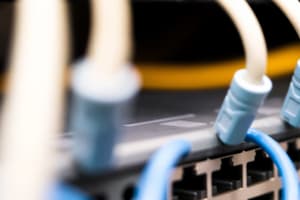Podcast
Questions and Answers
What are the three main areas of router security?
What are the three main areas of router security?
- Network Security, User Authentication, Data Confidentiality
- Network Security, Data Confidentiality, User Authentication
- Physical Security, Network Security, User Authentication
- Physical Security, User Authentication, Data Confidentiality (correct)
Which of these are NOT types of router security approaches?
Which of these are NOT types of router security approaches?
- DMZ Approach
- Single Router Approach
- Intrusion Detection System (IDS) Approach (correct)
- Defense in Depth Approach
Which one of these is NOT a secure administrative access task?
Which one of these is NOT a secure administrative access task?
- Ensure the confidentiality of data (correct)
- Authenticate access
- Restrict device accessibility
- Log and account for all access
What types of remote access to a router are mentioned in the text?
What types of remote access to a router are mentioned in the text?
What is a recommendation for creating a strong password?
What is a recommendation for creating a strong password?
What is the name of the command used to configure privilege levels?
What is the name of the command used to configure privilege levels?
What is the default privilege level for login with the router prompt?
What is the default privilege level for login with the router prompt?
Which privilege level is reserved for the enable mode privileges?
Which privilege level is reserved for the enable mode privileges?
What is the name of the mode accessed at the router# prompt?
What is the name of the mode accessed at the router# prompt?
What is the purpose of configuring privilege levels?
What is the purpose of configuring privilege levels?
What are the two ways to connect to an SSH-enabled router? (Select all that apply)
What are the two ways to connect to an SSH-enabled router? (Select all that apply)
Which of these is NOT a common SSH client?
Which of these is NOT a common SSH client?
Which of these options are NOT limitations of privilege levels?
Which of these options are NOT limitations of privilege levels?
What is the primary purpose of role-based CLI access?
What is the primary purpose of role-based CLI access?
Which of the following is NOT a typical task associated with the "Security operator" role in a role-based CLI configuration?
Which of the following is NOT a typical task associated with the "Security operator" role in a role-based CLI configuration?
The Cisco IOS Resilient Configuration feature is primarily designed to:
The Cisco IOS Resilient Configuration feature is primarily designed to:
What is the main function of the syslog feature?
What is the main function of the syslog feature?
What is the primary advantage of using SNMPv3 over previous versions of SNMP?
What is the primary advantage of using SNMPv3 over previous versions of SNMP?
Which of the following is a method of managing a Cisco device remotely, not using in-band management?
Which of the following is a method of managing a Cisco device remotely, not using in-band management?
What is one characteristic of a weak password?
What is one characteristic of a weak password?
Which option best describes a strong password?
Which option best describes a strong password?
Which command syntax is used to configure an unencrypted password?
Which command syntax is used to configure an unencrypted password?
What is one of the virtual login security enhancements mentioned?
What is one of the virtual login security enhancements mentioned?
How can system logging assist in login management?
How can system logging assist in login management?
Deliberately misspelling a password can enhance its strength.
Deliberately misspelling a password can enhance its strength.
Passwords should be written down and stored in obvious places.
Passwords should be written down and stored in obvious places.
A password consisting only of simple dictionary words is considered weak.
A password consisting only of simple dictionary words is considered weak.
Generating system-logging messages is not beneficial for login detection.
Generating system-logging messages is not beneficial for login detection.
It is advisable to change passwords often for better security.
It is advisable to change passwords often for better security.
A strong password should be at least 10 characters long.
A strong password should be at least 10 characters long.
The single router approach is the only method for securing an edge router.
The single router approach is the only method for securing an edge router.
SSH is used for secure remote management of devices.
SSH is used for secure remote management of devices.
The task of presenting legal notification is part of securing device access.
The task of presenting legal notification is part of securing device access.
Using a mix of symbols and spaces is not recommended for strong passwords.
Using a mix of symbols and spaces is not recommended for strong passwords.
Level 0 is predefined for administrative access privileges.
Level 0 is predefined for administrative access privileges.
Privilege level 15 is reserved for enable mode privileges.
Privilege level 15 is reserved for enable mode privileges.
A Cisco router can only function as an SSH client.
A Cisco router can only function as an SSH client.
Level 1 offers the highest command availability at the router prompt.
Level 1 offers the highest command availability at the router prompt.
SSH clients like PuTTY and OpenSSH can be used to connect to SSH-enabled routers.
SSH clients like PuTTY and OpenSSH can be used to connect to SSH-enabled routers.
Privilege levels range from 0 to 15.
Privilege levels range from 0 to 15.
User EXEC mode corresponds to privilege level 0.
User EXEC mode corresponds to privilege level 0.
Command availability can be customized between levels 2 and 14.
Command availability can be customized between levels 2 and 14.
Commands available at lower privilege levels are always executable at higher privilege levels.
Commands available at lower privilege levels are always executable at higher privilege levels.
The role of a WAN engineer includes configuring firewall settings.
The role of a WAN engineer includes configuring firewall settings.
Assigning a command with multiple keywords restricts access to specific commands that utilize those keywords.
Assigning a command with multiple keywords restricts access to specific commands that utilize those keywords.
The Cisco IOS resilient configuration feature is designed to secure the Cisco IOS image and configuration files.
The Cisco IOS resilient configuration feature is designed to secure the Cisco IOS image and configuration files.
In-band management refers to management access that occurs through a separate channel, like a dedicated console port.
In-band management refers to management access that occurs through a separate channel, like a dedicated console port.
Secure SNMPv3 access can be configured using Access Control Lists (ACL).
Secure SNMPv3 access can be configured using Access Control Lists (ACL).
Configuring NetFlow is part of the responsibilities of a security operator.
Configuring NetFlow is part of the responsibilities of a security operator.
Flashcards
Weak Password
Weak Password
A weak password like 'secret' uses easily identifiable information and is easy to guess.
Strong Password
Strong Password
A strong password like '12^h u4@1p7' includes alphanumeric characters, symbols, and spaces, making it hard to guess.
Password Change Frequency
Password Change Frequency
Change passwords often to enhance security and reduce risks of compromise.
Secret Password Algorithms
Secret Password Algorithms
Signup and view all the flashcards
Login Security Enhancements
Login Security Enhancements
Signup and view all the flashcards
Edge Router Security Approaches
Edge Router Security Approaches
Signup and view all the flashcards
Secure Administrative Access
Secure Administrative Access
Signup and view all the flashcards
Secure Local and Remote Access
Secure Local and Remote Access
Signup and view all the flashcards
Strong Password Guidelines
Strong Password Guidelines
Signup and view all the flashcards
SSH Daemon Configuration
SSH Daemon Configuration
Signup and view all the flashcards
SSH Connection Types
SSH Connection Types
Signup and view all the flashcards
SSH Clients
SSH Clients
Signup and view all the flashcards
Privilege Level 0
Privilege Level 0
Signup and view all the flashcards
Privilege Level 1
Privilege Level 1
Signup and view all the flashcards
Privilege Levels 2-14
Privilege Levels 2-14
Signup and view all the flashcards
Privilege Level 15
Privilege Level 15
Signup and view all the flashcards
Role-Based CLI Access
Role-Based CLI Access
Signup and view all the flashcards
User EXEC Mode
User EXEC Mode
Signup and view all the flashcards
Limitations of Privilege Levels
Limitations of Privilege Levels
Signup and view all the flashcards
Security Operator Privileges
Security Operator Privileges
Signup and view all the flashcards
WAN Engineer Privileges
WAN Engineer Privileges
Signup and view all the flashcards
Cisco IOS Resilient Configuration
Cisco IOS Resilient Configuration
Signup and view all the flashcards
Syslog
Syslog
Signup and view all the flashcards
Secure SNMPv3 Access
Secure SNMPv3 Access
Signup and view all the flashcards
Password Complexity
Password Complexity
Signup and view all the flashcards
Password Change Best Practices
Password Change Best Practices
Signup and view all the flashcards
Secret Password Types
Secret Password Types
Signup and view all the flashcards
Login Delay Implementation
Login Delay Implementation
Signup and view all the flashcards
Login Failure Logging
Login Failure Logging
Signup and view all the flashcards
Defense in Depth Approach
Defense in Depth Approach
Signup and view all the flashcards
Three Areas of Router Security
Three Areas of Router Security
Signup and view all the flashcards
Remote Access Using SSH
Remote Access Using SSH
Signup and view all the flashcards
Legal Notification
Legal Notification
Signup and view all the flashcards
SSH Server
SSH Server
Signup and view all the flashcards
Level 0 Privileges
Level 0 Privileges
Signup and view all the flashcards
Level 1 Privileges
Level 1 Privileges
Signup and view all the flashcards
Level 15 Privileges
Level 15 Privileges
Signup and view all the flashcards
Configuring Privilege Levels
Configuring Privilege Levels
Signup and view all the flashcards
Study Notes
Chapter 2: Securing Network Devices
- This chapter focuses on securing network devices, specifically Cisco routers.
- The CCNA Security v2.0 curriculum is being used.
- Dr. Nadhir Ben Halima is the instructor.
- The course follows a structured chapter outline, covering topics from introduction to summary.
Chapter Outline
- The chapter is organized into subsections, including:
- Introduction
- Securing Device Access
- Assigning Administrative Roles
- Monitoring and Managing Devices
- Using Automated Security Features
- Securing the Control Plane
- Summary
Section 2.1: Securing Device Access
- Upon completion of this section, students should be able to explain securing a network perimeter, configure secure administrative access to Cisco routers, configure enhanced security for virtual logins, and configure an SSH daemon for secure remote management.
Topic 2.1.1: Securing the Edge Router
- This section focuses on edge router security.
- Approaches outlined include:
- Single Router Approach
- Defense in Depth Approach
- DMZ Approach
- IP addresses are given for LAN 1 (e.g., 192.168.2.0)
Three Areas of Router Security
- Physical Security
- Router Operating System and Configuration File Security
- Router Hardening
Secure Administrative Access
- Tasks for securing administrative access include:
- Restricting device accessibility
- Logging and accounting for all access
- Authenticating access
- Authorizing actions
- Presenting legal notification
- Ensuring data confidentiality
Secure Local and Remote Access
- Diagrams illustrate local access methods (vty, console, aux ports) and remote access using Telnet/SSH, and modem/aux port. Different types of local and remote connections are shown.
Topic 2.1.2: Configuring Secure Administrative Access
- This section details techniques for configuring secure administrative access, including strong password guidelines.
Strong Passwords
- Strong passwords are crucial and include:
- Length of 10 or more characters
- Mix of uppercase and lowercase letters, numbers, symbols, and spaces
- Avoiding passwords based on easily identifiable information
- Deliberately misspelling words as passwords
- Changing passwords frequently
- Avoiding writing down passwords in obvious places
- Examples of weak and strong passwords are provided.
Increasing Access Security
- Demonstrates configuring password encryption and setting timeouts for console and vty lines. Specific configuration commands are given (e.g.,
security passwords min-length 10,service password-encryption).
Secret Password Algorithms
- Describes configuring different password types (type 8 and type 9). Syntax for enabling unencrypted passwords is provided (e.g.,
enable algorithm-type {md5|scrypt|sha256}).
Securing Line Access
- Provides commands for securing console, aux, and vty lines (e.g., disabling passwords, enabling SSH). Specific commands are shown (e.g.,
username Bob algorithm-type scrypt secret cisco54321).
Topic 2.1.3: Configuring Enhanced Security for Virtual Logins
- This section discusses enhancements to virtual login security.
Enhancing the Login Process
- Enhancements for virtual login security include:
- Implementing delays between successive login attempts
- Enabling login shutdown if DoS attacks are suspected
- Generating system-logging messages for login detection
Enable Login Enhancements
- Includes commands for login delay, preventing excessive login attempts, and setting time limits for login attempts. Example commands are given (e.g.,
login block-for 120 attempts 5 within 60,login delay 3).
Logging Failed Attempts
- Shows examples of generating login syslog messages. Example commands are provided (
login on-success log [every login],security authentication failure rate threshold-rate log).
Topic 2.1.4: Configuring SSH
- Describes steps for configuring SSH access. This includes key generation, and using the
show crypto keycommand to verify key details.
Steps for Configuring SSH
- Details the process of creating and using SSH configuration.
- Includes the 'show crypto key' command and checking if SSH 1.99 is enabled.
Connecting to an SSH-Enabled Router
- Describes how to connect, either as a server or a client using SSH. Supported client tools are mentioned (e.g., PuTTY, OpenSSH, TeraTerm).
Section 2.2: Assigning Administrative Roles
- Upon completing this section, students should be able to configure administrative privilege levels and role-based CLI access to control command availability.
(and so on, continuing with the rest of the existing study notes, each section updated with details and additional information)
Studying That Suits You
Use AI to generate personalized quizzes and flashcards to suit your learning preferences.




